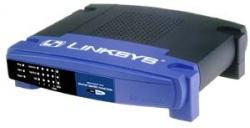Routers
Article stolen from wikipedia

A router is a computer networking device that forwards data packets toward their destinations through a process known as routing. Routing occurs at layer 3 (Network layer) of the OSI seven-layer model.
Routing is most commonly associated with the Internet Protocol, although other less-popular routed protocols remain in use.
In the original 1960s-era of routing, general-purpose computers served as routers. Although general-purpose computers can perform routing, modern high-speed routers are highly specialised computers, generally with extra hardware added to accelerate both common routing functions such as packet forwarding and specialised functions such as IPsec encryption.
Other changes also improve reliability, such as using DC power rather than line power (which can be provided from batteries in data centers), and using solid-state rather than magnetic storage for program loading. Large modern routers have thus come to resemble telephone switches, with whose technology they are currently converging and may eventually replace, whilst small routers have become a common household item.
The first modern (dedicated, standalone) routers were the Fuzzball routers.
A router can be used to either connect at least two networks, or to form a mobile ad-hoc network. A special variety of router is the one-armed router used to route packets in a virtual LAN environment. In the case of a one-armed router the multiple attachments to different networks are all over the same physical link.
A router that connects clients to the Internet is called an edge router. A router that serves to transmit data between other routers is called a core router.
A router creates and/or maintains a table, called a "routing table" that stores the best routes to certain network destinations and the "routing metrics" associated with those routes. See the routing article for a more detailed discussion of how this works.
In recent times many routing functions have been added to LAN switches, creating "Layer 2/3 Switches" which route traffic at near wire speed.
Routers are also now being implemented as Internet gateways, primarily for small networks like those used in homes and small offices. This application is mainly where the Internet connection is an always-on broadband connection like cable modem or DSL. These are not "routers" in the true sense, but the terminology has been confused with network address translation.
As Routers are costly devices they can't be used generally for education purposes, so simulation software is availaible for this :
eg, Boson Netsim For CCNP
Contents |
Router manufacturers
- 3Com (www.3com.com)
- Alcatel (www.alcatel.com)
- Belkin (www.belkin.com)
- Billion (www.billion.com)
- Cisco Systems, Inc. (www.cisco.com)
- D-Link Systems (www.dlink.com)
- Enterasys Networks (www.enterasys.com)
- Huawei Technologies (www.huawei.com)
- Juniper Networks (www.juniper.net)
- Linksys (www.linksys.com)
- Mikrotik (www.mikrotik.com)
- NETGEAR (www.netgear.com)
- Nortel (www.nortelnetworks.com)
- Pivotal Networking (www.pivnet.com)
- Siemens AG (www.siemens.com)
- SMC Networks (www.smc.com)
- Tellabs (www.tellabs.com)
- MRV Communications (www.mrv.com)
- Zoom Telephonics (www.zoom.com)
Routing Software
- Windows XP Internet Connection Sharing
- Mac OS X Internet Sharing
- Basic Internet Routing Daemon ( bird.network.cz )
- fdgw
- FREESCO
- GNU Zebra (www.zebra.org)
- Quagga (quagga.net)
- SmoothWall (smoothwall.org)
- IPCop (www.ipcop.org)
- The Linux Router Project[1]
- m0n0wall (m0n0.ch/wall)
[1]Most Unix-like operating systems include all necessary software to perform routing; the Linux Router Project is an example of a Linux distribution that specialises in routing.
See also
External links
- www.bsdrouter.org - website that covers router software based on BSD operating systems
- HowStuffWorks: How Routers Work by Curt Franklin
![[Main Page]](http://www.overclockers.com.au/wiki/skins/common/images/wiki.png)